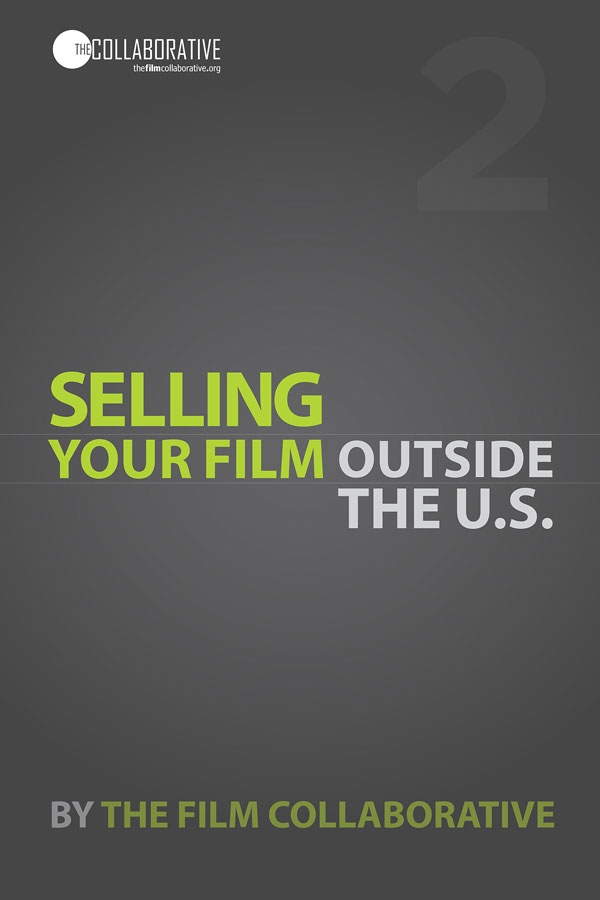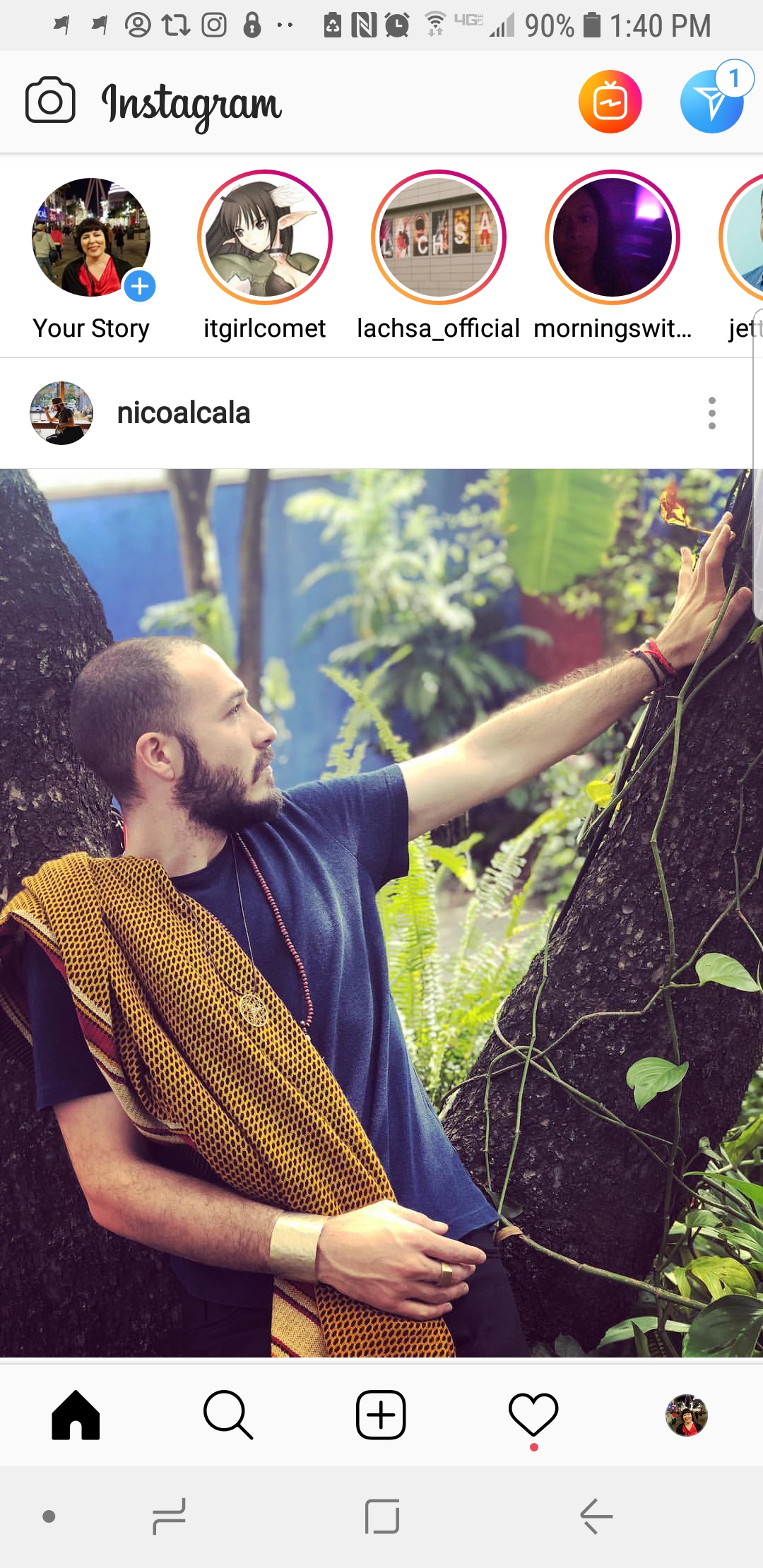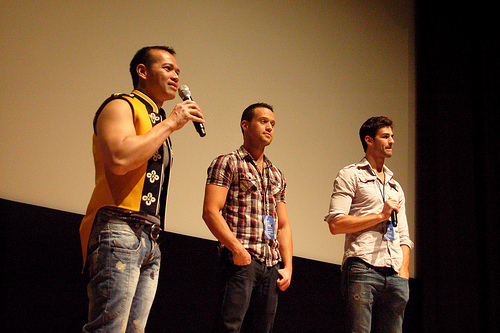
Will The New Blockchain Technology Put the Trust Into Film Distribution? (Part 2 of a 3-part series on Blockchain)
May 2, 2018 • Sheri Candler, TFC Social Media Advisor
Part 2 of a two-part series on blockchain technology. Please access the first part here.

Heralded as the “trust machine,” blockchain aims to tackle a big issue: lessening the intermediaries that could potentially interfere with data and information. Processes that rely on a high degree of trust (banking, property sales, insurance, etc.) usually rely on a multitude of third parties to add expertise and integrity to transactions, especially those involving agreements between unknown parties.
With blockchain, counterparties don’t need to have an established trust relationship.
The reason this can be an a game-changer for the business of film is it could eliminate many of the intermediaries (and fees!) involved in rights management, revenue disbursement, and content licensing. Currently, the film sales process depends on written agreements between sales agents and distributors within a variety of mediums (theatrical, educational, broadcast, VOD, EST, etc.), geographical territories and currencies. These agreements can take many months to finalize before allowing for consumer sales, and revenue collection is slow.
Moreover, the revenue disbursement is often murky when it comes to the repayment of expenses, the subtraction of fees, and the parceling out what remains to those who have invested in the project. In theory, blockchain technology could ease this process through the use of smart contracts, facilitating virtual currency transactions, and protecting intellectual property by authenticating ownership and allowing rights to be granted.
But how close are we really to seeing this as a reality?
Edward Klaris is an attorney and recognized expert on intellectual property, privacy, and media law. He has spent 25 years in the media and entertainment industry for powerhouse companies like Condé Nast and The New Yorker Magazine. I asked him about digital rights and intellectual property rights management, where blockchain might be beneficial.
Ed Klaris: “First of all, let’s define the blockchain a little bit. The way I look at it, there are three different types of blockchains. There is a private block chain where the users and the providers are limited and identified through a private entry point. It’s a limited universe of people on that private blockchain. On the other side of the spectrum, there’s a public blockchain where neither users nor providers are necessarily identified in any kind of a rigorous way. This is like with Bitcoin where it doesn’t really matter who you are, you can buy Bitcoin by just going in and registering as whomever, you can be anonymous. The third type is a hybrid, all of the users are open so anyone can use it, but the providers of the content, for example, are governed. You can only be a content provider if you’ve satisfied certain registration requirements. That kind of block chain is really the type that I foresee being the media ecosystem where somebody is governing that blockchain and making sure that those who are providing content are known and trustworthy.”
Regarding protection against piracy, Klaris doesn’t think blockchain will stop this, but the new technology isn’t really conducive to pirated content.
Klaris: “In the open blockchain model, you can just rip somebody else’s movie just like they do today and put it onto a blockchain and it’s kind of immutably there. There is a risk that some piracy will occur, but I’m on the side of a not being particularly worried about that. The internet that’s been around for over 20 years is a much better vehicle for pirated work. Why would anybody want to go through the trouble of using blockchain for piracy today when you can do it so much easier on the Internet?”
One aspect that Klaris does see blockchain being suited for, and it is already being set up to service, is registry of rights holders and payments to them.
Klaris: “That part of the equation has largely been focused in the music space today. There are a couple of entities that are focusing on it in particular. There is a company called Dot Blockchain, which is producing a registry of copyright holders in the music business.”
“As you probably know, a given song might be owned by 10 different people with different addresses each of whom share 100 percent in the royalties. You need to know who they are, and where they are, and blockchain could be an excellent place to create these registries because people are authenticated or registered. Who they are, where they live, and what percentage of ownership they have can be packaged in the blockchain and payments can be made to them.”
“In a place like the music streaming services, people will listen and there is a small royalty that needs to be paid to the musician. Often those individuals cannot be found, therefore money goes unsent. But in the blockchain scenario where you’ve got a big registry of people who have identified their tracks and identified themselves, you could be able to find them and pay them through their registration.”
“But everybody is trying to go at this in their own little silos, solving for the same problems because there is a bit of a gold rush going on. There’s not a lot of cross platform use. If you register in one place, that information will not be carried over to the next place and, right now, there’s just no standardization whatsoever and that’s causing trouble. But as a concept, definitely people will be registering themselves and their works so they can be paid.”
In the realm of independent film, there are a few companies planning to start employing blockchain technology for a variety of applications. One such company is Vevue, a peer-to-peer video network app running on the Qtum blockchain platform. Vevue currently offers an iOS app. Founder Thomas Olson says their platform is different than video social networks like YouTube, or streaming professional content from Netflix because Vevue is engineered to seamlessly integrate with blockchain.
Thomas Olson: “Vevue chose Qtum because it’s a mobile first platform. With mobile, we’re targeting the easiest path to consumer adoption and ultimately benefit from the mobile viewing experience easily transferring through to our web portal. Qtum, also seeing potential in Vevue, invested in our team early—making us the very first app to build on the Qtum blockchain. We actually spent the last 10 months incubating in their Shanghai office space, the first and only team to do so.”
“Distributing a film on the blockchain means filmmakers can reach a worldwide audience without having to go through centralized services like Netflix or YouTube. The process is quite simple for organized professionals:
- Visit CoMakery.com and create a Token representing ownership in your content, then distribute accordingly among your contributors. For the film industry, this is especially important as investors need to be paid back their initial investment plus a premium before those same investors can share in the profits with the producer pool. In short, more revenue and a transparent accounting of that revenue ensure all parties are paid in a timely and fair manner without the need for audits.
- Next, you upload your content to Vevue and put the blockchain paywall in place. For the film industry, as opposed to commercial and amateur Vevue users, there are a few additional steps regarding deliverables. To handle this, we’ve partnered with Two Roads Picture Co., the distributor of the film No Postage Necessary, to be our exclusive aggregator to service both studio and independent films wanting to distribute through Vevue.
- Finally, collect revenue. Anytime someone pays—revenue immediately flows back to contributors per the CoMakery Token.”
Indie film “No Postage Necessary” is teaming up with Vevue for distribution in June 2018
Olsen: “Domestically, we can support traditional theatrical distribution by dropping tokens into each theater playing the film. Audience members simply record a review, upload it, and collect token reward. Then our API organizes the reviews for sites like Rotten Tomatoes or IMDb to easily add next to written reviews. This incentivizes audiences and provides feedback and audience building for the distributor. On the streaming side, we’d enter the competition fold alongside traditional TVOD platforms such as iTunes, Google Play, and Amazon. We’d provide the same viewing experience with the benefit of copyright protection and transparent royalty payments for the filmmaker. And since there would be no middleman, the filmmaker would get to keep more of the revenue.”
“On the foreign side—distributing a film on blockchain means filmmakers can reach a worldwide audience without having to sell to traditional distributors in international territories. It also means we can reach more people. When you consider there are over 2 billion unbanked people in the world and many of them have smartphones, we’re now providing an entirely new group the ability to legally purchase entertainment content.”
“Other than the fact they’ll be using Vevue Tokens to interact with our functions/features, audiences should barely notice they’re using blockchain. When it comes to film, our aim is to provide the same viewing experience one would have if he or she were using a traditional centralized platform.”
Perhaps this is the best way to look at the technology. Blockchain will be the unseen backbone that powers virtual currency, content distribution, rights management and revenue payments, to name a few examples. Much like the Internet, it isn’t necessary to dive deeply into the mechanics of how this information is transferred in order to use it. In the near future, this technology will be used to power the functions that, for now, are opaque and unnecessarily complicated. An open and distributed ledger, or record book, will keep track of information and validate transactions without being centrally controlled by any one entity. This technology is only in the experimental stage now, but within 10-15 years will power many parts of the film business that we struggle with today.
Sheri Candler May 1st, 2018
Posted In: Blockchain, blockchain, Digital Distribution, Distribution
Tags: bitcoin, blockchain, Digital Distribution, Sheri Candler, The Film Collaborative
Self financed Film Distribution in the Context of European Territories
 Last May, TFC released the second book in our series called Selling Your Film Outside the US. As with everything in the digital space, we are trying to keep track of a moving target. Netflix has now launched in France, Germany, Austria, Switzerland, Belgium and Luxembourg. iTunes continues its transactional VOD domination by partnering with Middle East film distributor Front Row Filmed Entertainment to give Arabic and Bollywood films a chance to have simultaneous releases in eight countries: UAE, Egypt, Bahrain, Qatar, Oman, Lebanon, Jordan and Kuwait. Amazon has just launched several new original series in the US and UK, including critical darling Transparent, to a line up that includes returning series Alpha House and Betas.
Last May, TFC released the second book in our series called Selling Your Film Outside the US. As with everything in the digital space, we are trying to keep track of a moving target. Netflix has now launched in France, Germany, Austria, Switzerland, Belgium and Luxembourg. iTunes continues its transactional VOD domination by partnering with Middle East film distributor Front Row Filmed Entertainment to give Arabic and Bollywood films a chance to have simultaneous releases in eight countries: UAE, Egypt, Bahrain, Qatar, Oman, Lebanon, Jordan and Kuwait. Amazon has just launched several new original series in the US and UK, including critical darling Transparent, to a line up that includes returning series Alpha House and Betas.
But what does DIY Distribution mean in the context of European territories? The following is an excerpt included in the book:
Here are a few tips for any filmmaker who is thinking about doing digital distribution in general, but especially in multiple territories:
-If your film is showing at an international film festival, ask if they are producing subtitles, and, if so, negotiate that the produced file be part of your festival fee. It may need to be proofed again or adjusted at a subtitling and transcription lab later on, but as a first pass it could prove very valuable down the road. See more about the kind of file you need in this post;
-When you are producing your master, create a textless version of your feature. Apple and probably other platforms will not allow external subtitles on any films that already have burn-ins. If your film, for example, has a few non-English lines of dialogue, instead of burning-in English subtitles into your film, a better method would be to create an external English-language subtitle file (separate from closed captioning) in a proper format and submit it with your master. Different aggregators may require different formats, and if you are going to a Captioning/Transcription/Translation Lab to do your closed captioning and subtitling work, be smart about which questions you ask and negotiate a price for everything, including transcoding from one format to another because you may not know exactly what you will need for all your deals right away.
Subtitles need to be timed to masters, so make sure your time code is consistent. When choosing a lab, ascertain whether they are capable of fulfilling all your current and future closed captioning and subtitling needs by verifying that they can output in the major formats, including (but not limited to) SubRip (.srt), SubViewer 1 & 2 (.sub), SubStation Alpha (.ssa/.ass), Spruce (.stl), Scenarist (.scc) and iTunes Timed Text (.itt);
-You may want to band together with films that are similar in theme or audience and shop your products around as bundled packages. Many digital services, including cable VOD, have thematic channels and your bundle of films may be more attractive as a package rather than just one film;
-Put the time in toward building your brand and your fanbase. Marketing still is the missing piece of the puzzle here. As it gets easier and easier to get onto platforms, so too does it get more difficult for audiences to find the films that are perfectly suited to their interests. This is especially true when talking about marketing one’s film outside one’s home territory. If you are accessing platforms for your film on your own, YOU are the distributor and the responsibility of marketing the film falls entirely to you.
To download a FREE copy of the entire book, complete with case studies of films distributed in Europe, visit sellingyourfilm.com.
Sheri Candler October 15th, 2014
Posted In: Amazon VOD & CreateSpace, book, case studies, Digital Distribution, DIY, iTunes, Netflix
Tags: Amazon, Digital Distribution, Europe, film bundles, independent film, iTunes, Middle East, Netflix, Selling Your Film Outside the US, Sheri Candler
Distribution preparation for independent filmmakers-Part 4 Deliverables
By Orly Ravid and Sheri Candler
In the past 3 posts, we have covered knowing the market BEFORE making your film, how to incorporate the festival circuit into your marketing and distribution efforts and understanding terms, the foreign market and release patterns. In this post, we will discuss the items that will be required by sales agents, distributors (primarily digital distributors) and even digital platforms (if you are thinking of selling directly to your audience with less middlemen) before a deal can be signed and the film can be distributed.
Know your deliverables
Distribution is an expensive and complicated process and all distribution contracts contain a list of required delivery items (often attached at the end of the document as an exhibit) in order to complete the agreement. Without the proper items, sales agents and distributors will not be interested in making a deal. Your film must have all proper paperwork, music licenses, and technical specifications in order and these delivery items will incur additional costs to your production. Make sure to include a separate budget for deliverables within the cost of your production.
US sales agents and distributors will require insurance covering errors and omissions (E&O) at minimum levels of $1,000,000 per occurrence, $3,000,000 in the aggregate with a deductible of $10,000, in force for three years. E&O insurance protects the producer and distributor (usually for the distributor’s catalog of films) against the impact of lawsuits arising from accusations of libel, slander, invasion of privacy, infringement of copyright etc and can cost the producer in the range of $3,000 to $5,000. E&O insurance is required BEFORE any deal is signed, not after, and can take 3-5 days to obtain if all rights and releases, a title report and music clearances can be supplied.
Digital aggregators in general do not require E&O insurance unless it is for cable VOD and Netflix (these do). However, they do require closed captioning (around $900), subtitling (if you intend to distribute in non English speaking territories, usually costs around $3 per minute) and a ratings certificate (if distributing in some foreign territories, prices vary according to run time and ratings board).
The production will need to supply a Quality Control (QC) report, preferably from a reputable encoding house. If you film fails QC for iTunes and other digital platforms, it can be costly to fix the problems with the file and it will lead to a delay of the film’s release. MANY problems can be found in the QC process so whatever you think you are saving by encoding yourself or via a less reputable company, you will more than make up for in having to redo it. The most common problems arise from duplicate frames or merged frames as a result of changing frame rates; audio dropouts or other audio problems; sync problems from closed caption or subtitling files.
Distributors will accept a master in Apple ProRes HQ 422 file on an external hard drive or HD Cam. By far, the digital drive is preferable to tape and unless your distributor specifically requests HD Cam, do not go to the expense of creating this. The master should NOT have pre roll advertising, website URLs, bars/tones/countdowns, ratings information, or release date information. For digital files, content must begin and end with at least one frame of black.
Other delivery items required by sales agents/distributors include: trailer (preferably 2 minutes) in the same aspect ratio as the film with no nudity or profanity; chapter points using the same time code as the master file; key art files as a layered PSD or EPS with minimum 2400 pixels wide at 300 dpi; at least 3-5 still images in high resolution (traditional distributors often require as many as 50 still images) and already approved by talent; DVD screeners; press kit which includes a synopsis, production notes, biographies for key players, director, producer, screenwriter, and credit list of both cast and crew; pdf of the original copyright document for the screenplay and the motion picture; IRS W-9 form or tax forms from governments of the licensor; music cue sheet and music licenses.
There are technical specifications that need to be met as far as the video and audio files. Most post production supervisors are aware of these. It is also not unheard of to be asked to supply 35 mm prints for foreign distribution if a theatrical release is desired or contractually obligated.
Sometimes if your film is considered a hot property, a distributor might be willing to create the delivery items at their expense in exchange for full recoupment and/or a greater cut of the revenues. But do not count on this. We have heard from many filmmakers who didn’t clear music rights for their films, assuming a distributor would take on this expense, and were sorely disappointed to find none would do that. If you can’t supply the delivery list, no agreement will be signed.
Sheri Candler July 23rd, 2014
Posted In: Digital Distribution, Distribution, International Sales
Tags: deliverables, Digital Distribution, digital film distribution, distribution contracts, film distribution, film distributors, independent film, Orly Ravid, preparing for film distribution, Sheri Candler
Distribution preparation for independent filmmakers-Part 3 Terms, foreign and windows
By Orly Ravid and Sheri Candler
In the past 2 posts, we have covered knowing the market BEFORE making your film and how to incorporate the festival circuit into your marketing and distribution efforts. This post will cover terms you need to know; whether a foreign distribution agreement is in your film’s future and what to do if it isn’t; the patterns, or windows, that need to be considered in your release. Just to be clear, we are targeting these posts mainly to filmmakers who seek to self finance and actively control their distribution. If that is not your plan, the usefulness of these posts may vary.
Distributors; platforms; aggregators; self hosting sites; applications
If you are new to the distribution game, here are some terms you now need to be familiar with.
Distributors (ie. A24, Oscilloscope, Fox Searchlight, Sony Classics, The Weinstein Company, Roadside Attractions) take exclusive rights to your film for a negotiated period of time and coordinate its release. These companies often acquire independent films out of the most prestigious film festivals and pay decent advances for ALL RIGHTS, sometimes even for ALL TERRITORIES. A signed and binding contract takes all responsibility for the film away from its creator and places it with the distributor to decide how to release it into the public. Distribution through these entities entails theatrical, digital, DVD, educational, leisure (airline/hotel/cruiseship).
Platforms (ie. iTunes, Amazon Prime, Google Play, Hulu, Netflix, cable VOD) are digital destinations where customers watch or buy films. Viewing happens on a variety of devices and some allow for worldwide distribution. Mainly platforms do not deal directly with creators, but insist on signing deals with representative companies such as distributors or aggregators.
Aggregators (ie. Premiere Digital, Inception Media Group, BitMAX, Kinonation) are conduits between filmmakers/distributors and platforms. Aggregators have direct relationships with digital platforms and often do not take an ownership stake. Aggregators usually focus more on converting files for platforms, supplying metadata, images, trailers to platforms and collecting revenue from platforms to disperse to the rights holder. Sometimes distributors (Cinedigm, FilmBuff) also have direct relationships with digital platforms, helping reduce the number of intermediaries being paid out of the film’s revenue.
Self hosting sites (ie. VHX, Distrify, Vimeo on Demand) are all services that allow filmmakers to upload their films and host them on whatever website they choose. Vimeo on Demand also hosts the video player on its own central website and has just integrated with Apple TV to allow for viewing on in-home TV screens.
Applications for many digital platforms can be found on mobile devices (smartphones and tablets),Over the Top (OTT) internet-enabled devices like Roku, Chromecast, Apple TV, Playstation and Xbox and on smart TVs. Viewers must add the applications to their devices and then either subscribe or pay per view to the platforms in order to see the film.
What about international?
In the latest edition of our Selling Your Film book series, Amsterdam based consultant Wendy Bernfeld goes into great depth about the digital distribution market in Europe. Many low-budget, independent American films are not good candidates for international sales because various international distributors tend to be attracted to celebrity actors or action, thriller and horror genre fare that translate easily into other languages.
Rather than give all of your film’s rights to a foreign sales agent for years (often 7-10 years duration) just to see what the agent can accomplish, think seriously about selling to global audiences from your own website and from sites such as Vimeo, VHX, Google Play and iTunes. The volume of potential viewers or sales it takes to attract a foreign distributor to your film is often very high. But just because they aren’t interested doesn’t mean there is NO audience interest. It simply means audience interest isn’t high enough to warrant a distribution deal. However, if you take a look at your own analytics via social media sites and website traffic, you may find that audience interest in foreign territories is certainly high enough to warrant self distributing in those territories. Look at this stats page on the VHX site. There are plenty of foreign audiences willing to buy directly from a film’s website. Why not service that demand yourself and keep most of the money? Plus keep the contact data on the buyers, such as email address?
Often, sales agents who cannot make foreign deals will use aggregators to access digital platforms and cut themselves into the revenue. You can save this commission fee by going through an aggregator yourself. In agreements we make with distributors for our Film Collaborative members, we negotiate for the filmmaker to have the ability to sell worldwide to audiences directly from their website. If you are negotiating agreements directly with distributors, the right to sell directly via your own website can be extremely beneficial to separate and carve out because sales via your website will generate revenue immediately. However, this tactic is now being scrutinized by distributors who are allowing direct to audience sales by filmmakers, but asking in their agreement for a percentage of the revenue generated. It is up to the filmmaker to decide if this is an acceptable term.
If you do happen to sell your film in certain international territories, make sure not to distribute on your site in a way that will conflict with any worldwide release dates and any other distribution holdbacks or windowing that may be required per your distribution contracts. An example: You have signed a broadcast agreement that calls for a digital release holdback of 90 days-6 months-1 year or whatever. You cannot go ahead and start selling via digital in that territory until that holdback is lifted. Instead, use a hosting service that will allow you to geoblock sales in that territory.
Know your windows.
If you do decide to release on your own, it’s important to know how release phases or “windows” work within the industry and why windowing was even created.
The release window is an artificial scarcity construct wherein the maximum amount of money is squeezed from each phase of distribution. Each window is opened at different times to keep the revenue streams from competing with each other. The reason it is artificial is the film continues to be the same and could be released to the audience all at one time, but is purposely curbed from that in order to maximize revenue and viewership. The Hollywood legacy window sequence consists of movie theaters (theatrical window), then, after approximately 3-4 months, DVD release (video window). After an additional 3 months or so, a release to Pay TV (subscription cable and cable pay per view) and VOD services (download to own, paid streaming, subscription VOD) and approximately two years after its theatrical release date, it is made available for free-to-air TV.
Now, there is a lot of experimentation with release windows. Each release window is getting shorter and sometimes they are opened out of the traditional sequence. Magnolia Pictures has pioneered experimentation with Ultra VOD release, the practice of releasing a film digitally BEFORE its theatrical window and generally charging a premium price; and with Day and Date, the practice of releasing a film digitally and theatrically at the same time. Many other distributors have followed suit. Radius-TWC just shortened the theatrical only window for Snowpiercer by making it available on digital VOD within only 2 weeks of its US theatrical release. During its first weekend in US multiplatform release, Snowpiercer earned an estimated $1.1 million from VOD, nearly twice as much as the $635,000 it earned in theaters.
So, while there are certainly bends in the rules, you will need to pay attention to which release window you open for your film on what date. For example, it might be enticing to try to negotiate a flat licensing fee from Netflix (Subscription VOD or SVOD window) at the start of release. However, from a filmmaker’s (and also distributor’s) perspective, if the movie has not yet played on any other digital platforms, it would be preferable to wait until after the Transactional VOD (TVOD) window in order to generate more revenue as a percentage of every TVOD purchase, before going live on Netflix. If the transactional release and subscription release happen at the same time, it cannibalizes transactional revenue.
Also, sites like Netflix will likely use numbers from a film’s transactional window purchases to inform their decision on whether to make an offer on a film and how big that offer should be. Subscription sites such as Netflix also pay attention to general buzz, theatrical gross, and a film’s popularity on the film’s website. There is value in gathering web traffic analytics, email database analytics and website sales data in order to demonstrate you have a sizable audience behind your film. This is useful information when talking to any platform where you need their permission to access it. Caution: Netflix is not as interested in licensing independent film content as it once was. If your film is not a strong performer theatrically, or via other transactional VOD sites; does not have a big festival pedigree; or does not have notable actor names in it, it may not achieve a significant Netflix licensing fee or they may refuse to license it for the platform. Netflix is no longer building its brand for subscribers and it has significant data that guides what content it licenses and what it produces.
Also be aware that some TV licensing will call for holding back Subscription VOD (SVOD) releases for a period of time. If your film is strong enough to achieve a broadcast license deal, you will need to wait before making a subscription release deal. On the other hand, holding out too long for a broadcast distribution offer might cause the publicity and interest you’ve generated for your film to dissipate.
If your film is truly a candidate for theatrical release, most cinemas will not screen a film that is already available on TVOD or SVOD services. In fact, most of the chain cinemas will not screen a film that is available in any other form prior to or at the same time as theatrical release.
The way you choose to release your film is a judgment call in order to reach your particular goal. All decisions have consequences and you will have to live with the decisions you make in releasing your film. Like all decisions, you base them on what you know at the time with no guarantee as to how they will turn out.
Sheri Candler July 16th, 2014
Posted In: Digital Distribution, Distribution, Distribution Platforms, DIY, International Sales, Theatrical
Tags: aggregators, Distrify, independent film distribution, Orly Ravid, release windows, Sheri Candler, SVOD, The Film Collaborative, theatrical distribution, TVOD, VHX, Vimeo on Demand, Wendy Bernfeld
Distribution preparation for independent filmmakers-Part 2-Festivals
By Orly Ravid and Sheri Candler
We continue this month’s series covering the practicalities behind successfully marketing and distributing an independent film with limited resources. Please see Part 1 on knowing the market for your film HERE.
Part 2-Temper festival expectations and don’t wait too long to release.
While you may be targeting top-tier festivals like Sundance, Toronto, Berlin, Telluride and SXSW (Austin’s South by Southwest) where acquisition executives attend and search for films to acquire, your film may not be chosen for these festivals. Be prepared for this disappointment and have a backup plan. If your film fails to be selected, your distribution options are likely to change as well. The best acquisition prices are paid by the most reputable companies for films out of these top tier fests. While you may receive offers for distribution even if your film doesn’t have this type of premiere, those offers will be lower in scope and usually from either up and coming companies (ie, start ups with little money) or companies whose reputations are not as prominent.
Should you continue submitting to other festivals and stay on the circuit? TFC colleague Jeffrey Winter has handled festival distribution for countless films, but mainly the films TFC picks up for festival distribution either come from A list festivals or have some kind of specific niche appeal. He advises “For any film that is performing well on the circuit (meaning getting accepted into a significant number of festivals on a more or less regular basis), there is a general rule you can follow. Most films will see their festival bookings continue robustly for 1 year from the date of the world premiere, and then significantly drop off (but still trickle in) in months 12 – 18. After 18 months, festival bookings will nearly cease worldwide. Given that general rule, I am going to go ahead and call that 18 months the ‘Festival Window.’”
“For filmmakers and many small distribution companies, the festival window is invaluable and irreplaceable in terms of the marketing/publicity value it can afford, and the modest revenue that can be generated for certain kinds of films (prestige festival films, films that fit within the programming of specific niche festivals), especially if they can secure European festival placement. When working with a modest budget, any and all revenue the film can bring in is significant. Additionally, the free marketing/publicity that a festival offers is just about the only kind of marketing the film may ever get.”
Assuming you achieve regional festival screenings, will you use it as a form of theatrical tour, gathering press coverage and fans in regional areas in order to fuel your digital sales? If so, how to transition that coverage and word of mouth into the digital rollout, when is that rollout going to happen and who is going to coordinate it? These questions need to be answered.
Leaving too much time between a regional festival premiere and eventual digital and DVD sales is a mistake many independent filmmakers make. When publicity and good word of mouth recommendations are being generated from your festival screenings, set a firm deadline on when digital distribution will have to start should your distribution savior not appear. Don’t hold out indefinitely for distribution opportunities that may not come. Often, we are contacted by filmmakers who insist on spending a year or more on the festival circuit, without making any revenue and without significant distribution offers in sight. They are wasting revenue potential by continuing to hope a distribution savior will appear and refusing to move ahead with plans for the next phase of release (that will probably be handled on their own) because they didn’t budget for this situation or they have no idea of the options available. Note, it can take up to 4 months to go live on iTunes and other well known digital platforms. If you’re thinking of having a digital self release, plan accordingly.
If chosen for a festival, take full advantage of the screening as a marketing opportunity. It is imperative not only to enjoy face to face compliments at your screenings, but encourage people to use their social media accounts to tell others how great your film is. Many times filmmakers tell us about their sold out screenings at regional fests (or even pre release screenings) and how many people came up to them with kind words to say about the film. But in looking for those kind words online, sometimes we find very little or nothing being said. This is a troubling sign. No bump in Facebook Likes, Twitter followers, trailer views or website traffic? No one using a hashtag or @mention on Twitter or Instagram? No comments or shares of the film’s trailer from Youtube? Kind words in person are great for your personal morale, but in order to have beneficial word of mouth, people have to want to share news of your film and the normal outlet for doing that today is online. It is trackable too! Word of mouth won’t help with digital sales if no one is talking so make sure everyone you meet is aware of the film’s home online, its social media accounts, and where a trailer exists to be shared. You can’t MAKE people speak, you can only encourage it.
If you’re brash during a post screening Q&A, take a selfie à la Ellen DeGeneres at the Oscars and tell everyone you will post it to the film’s Twitter or Instagram account and what that account handle is. They are more likely to retweet or share it if you make it super easy and they are more likely to follow your account, visit the film’s website (so make sure the About section includes that URL link), maybe even sign up for your email alerts. Also, think a little differently about your film’s festival catalog description. If you want people to follow you as an artist and your film’s actors (a social media following is important for their career!), add Twitter handles/Instagram handles/FB page name etc to the paragraph you are asked to submit about your film. Technically, ALL festivals should want this kind of information included just as they now post website URLs. If audience members like the film performances, they also might like to follow the humans who gave them and the humans who made the film possible.
Instead of using a clipboard method to collect email addresses from your festival audience, look into using a text-to-subscribe service associated with your email provider. Mailchimp’s MobileChimp (UK, USA, Australia, Spain, France & Netherlands) and Constant Contact (US only) both have this capability. Put the keyword you choose to associate with your account on any printed material and be sure to say it out loud during your Q&A. An email database is worth its weight in gold throughout your release and further into your future work so don’t neglect to grow one while you are touring your film.
Add festival laurels from the most important/recognizable film festivals to your marketing materials. While we know the temptation is to put every laurel from every festival on your website banner, key art, postcards etc. it starts looking cluttered and inconsequential. The festivals with the most impact on your audience are the ones to include because they will have the most impact on purchases. Don’t forget the pull quotes to favorable critical reviews as well.
In going back to the discussion about digital release, is this release going to be worldwide or only in your home country? If your film has played festivals worldwide, it doesn’t make much sense to only release it within your own country, especially if you have all territories still open for sales. If you have signed agreements in some formats or in some territories, then those warrant compliance. But hoping for a foreign deal when you don’t have one even in your home country is unrealistic. Seriously consider releasing digitally worldwide when your launch comes.
In the next part of the series, we’ll take a look at the different players in film distribution and how to work with them.
Sheri Candler July 9th, 2014
Posted In: Digital Distribution, Distribution, Film Festivals, iTunes, Theatrical
Tags: Digital Distribution, distribution preparation, film distribution, Film Festivals, independent film, Jeffrey Winter, Orly Ravid, Sheri Candler, The Film Collaborative
Distribution preparation for independent filmmakers-a series
By Orly Ravid and Sheri Candler
This month’s series will cover the practicalities behind successfully marketing and distributing a film with limited resources. In this series, we will cover knowing the current distribution situation before developing a new project, the rewards and perils of the festival circuit, become familiar with the different players in film distribution and how to work with them effectively and wrap up with deliverables that will expected once you sign a deal.
This is part 1. Part 2, Part 3, Part 4, Part 5
Part 1-Understand the market
Independent film means risk.
A report published this year by Cultural Weekly cited fewer than 2% of the fully-finished, feature-length films submitted to the Sundance Film Festival (arguably the biggest festival for the best of independent film) will get any kind of distribution whatsoever. Of the more than $3 billion invested annually, less than 2% will ever be recouped. This is a reality of independent filmmaking and anyone who engages in it must understand the financial risk of doing so. It is best to evaluate your goals in making a film before starting out. It’s okay to have goals other than recouping a production budget. This is especially true of first or second films from those involved. In our opinion, films can be and should be about art, cultural connection, gaining experience and giving voice to the unheard. All are valid goals right up there with money. Patrons throughout the ages have supported the arts for many emotional reasons beyond making profit.
But if the ultimate goal is to fully recoup and be profitable, a realistic plan from the start describing how that is going to happen, and what it will realistically take to make that happen, needs to be in place before anyone sets foot on a set. The distribution marketplace is so fluid and challenging, even the best planning can result in a loss. Be prepared for the risk, with no complaining or blaming.
It’s natural for filmmakers and film investors to have high expectations for the release of their films, including a theatrical release, TV sales, international sales, a Netflix fee, a cable VOD/digital release and maybe DVD for shops that still carry them. At the same time, it’s important to understand how a release like this might be achieved and how many intermediaries are inserted into the money chain before the production will see any revenue to pay back financing. There are legitimate benefits in partnering with strong companies who have the relationships and expertise to achieve a release that the production envisions, but agreements with them may not be forthcoming if the film isn’t perceived to have breakout or mass audience potential. Or you may fall prey to the distributor who annually needs new product to fill the catalog and isn’t willing to give much market support to your film. Distribution companies profit on volume, but your film does not share in their volume profits.
Before starting a new project that has aspirations for a big market release, it is the responsibility of the producer/filmmaker to survey the market. Talk to sales agents who have recently returned from the major film markets (Berlin, Cannes, AFM etc) and find out what they are seeing as far as emerging demand or trends that have finished. Check sites like The Film Catalogue to see what is already in the market or will be soon. You can check by budget level, by genre, by release year or production stage and even dig deeper by seeing who is handling these films and what cast is attached. While this won’t be a comprehensive list because not every film being made has a sales agent attached, it will give a better idea of the competitive landscape for the kind of film you are seeking to make.
Keep up your knowledge of the industry by reading both the trade press and various organizational blogs. There is a lot of free and valuable information online from those working in the industry and from other filmmakers on sites including IndieWire, Filmmaker Magazine and MovieMaker Magazine, as well as blogs from Sundance, IFP, Film Independent and our own blog. You just have to subscribe to them, read religiously and analyze how that information benefits what you are trying to do. Alternatively, you can save yourself time by working with a distribution consultant knowledgeable about current distribution options and revenues. Caution: Always learn about ownership stakes and fees of intermediaries such as sales agents, aggregators and distributors because their fees and associated marketing costs reduce the amount of revenue that flows back to your production.
It is a good idea to confer with other filmmakers. It is our experience that the filmmaking community can be very giving when asked about how they accomplished something, and not just about production, but all aspects of getting their films to market. This is a useful way to learn from others’ experiences (and mistakes). Sharing stories helps you understand the reputations of companies you may be dealing with and especially key contact names within those companies. Many experienced filmmakers are mentors and are willing to make introductions if they can see a fit between your talent and a decision maker who can help.
Not only should you connect with the community online, but make it a point to attend offline events in person where you will pick up timely information, and form ongoing relationships that could help you later in your career. Labs, conferences, festivals and workshops are all regularly offered not just in Los Angeles, New York City, Toronto or London, but in many communities across the world. If you are serious about filmmaking as an occupation, you need to invest financially in your education and network building.
In the next post, we will talk about what can be gained from the festival circuit, how long to stay on the circuit with your film and why staying on it too long can be detrimental.
Orly Ravid July 2nd, 2014
Posted In: Distribution, DIY
Tags: film distribution, financial risk of independent film, independent film, market research for independent film, Orly Ravid, Sheri Candler, The Film Collaborative









